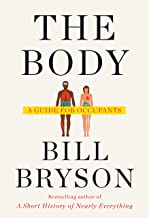The Body: A Guide for Occupants, Bill Bryson 2019
Fifty years ago, I was a fourth year medical student doing a visiting clerkship at Middlesex Hospital in London, England. My head had been crammed with anatomy, physiology, biochemistry, pathology, microbiology and other assorted ‘-ologies during two lecture-filled and library-dominated years in Ann Arbor, and now I was ready to inflict my own brand of personal clumsiness on other bodies. So it was with a certain sense of deja vu that I made my way through the 450 pages of Bryson’s book about our bodies since he has lived in the UK for many years and cited many British authorities during the course of this fascinating, entertaining, and informative book. Bryson is a masterful writer whether he is discoursing on “A Short History of Nearly Everything”, Shakespeare, the Appalachian Trail, his travels throughout the British Commonwealth, or his childhood in Iowa in the 1950’s, and this may be his best book yet. Filled with an enormous amount of information about our various organs and their functions and dysfunctions, he constantly and entertainingly distracts the reader just as she is about to nod off with an anecdote, a ‘can you believe this’ observation, or a witty bon mot. His history reminds us of how knowledge accumulates and how errant some of the current wisdom was in the not so distant past. From bleeding to adding radium to medications, from radical mastectomies to lobotomies, from childbed fever to false positive PSA tests for prostate cancer, medicine’s history is riddled with error and harm, and it probably wasn’t until 1950 that a patient had better than a 50/50 chance of benefiting from an encounter with a doctor. Antibiotics, vaccines, chemotherapy, statins, and anti-hypertensives have helped a great deal, but it may be public health measures such as clean water, better diets, and hygiene that have moved the average life expectancy in the US from 48 in 1900 towards the current situation where most of us who are economically well off can expect to see our 80’s. Though more than 90% of the book is about the body itself (can you believe that you have 25,000 miles of blood vessels, make 1.5 quarts of saliva/day, and have 1000 square feet of lung surface doing our breathing!!!!), Bryson also addresses American health care where we spend twice as much as other industrialized nations only to have an average life expectancy that is 39th in the world, slightly better than Albania. He points out that we have twice as many people engaged in billling/collecting the health dollars than we have doctors providing the health care. Since I have spent more than half a century in health care, I could go on forever about this fascinating topic that is our body, how it works, how it fails us due to disease and abuse, and how we deal with aging and end of life. Suffice it to say that this is another of Bryson’s brilliant efforts and, though it’s a long read, well worth the time and effort.



